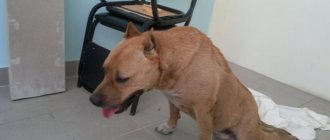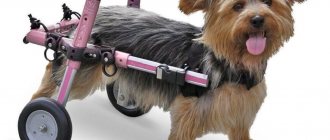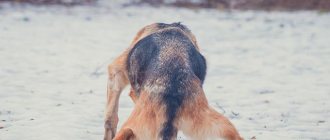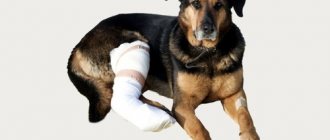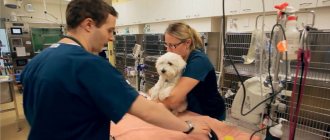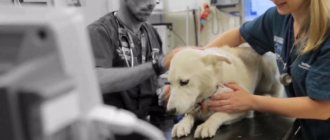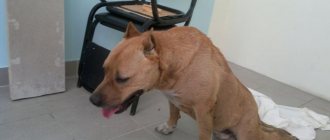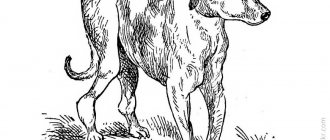Dachshunds are active, cheerful dogs with good health.
However, they are also characterized by some diseases that lead to serious consequences.
Often representatives of this breed have impaired mobility of the limbs, manifested by a change in gait or complete failure of the paws.
Paralysis of the limbs can be caused by various diseases, the symptoms of which all dachshund owners need to know about.
Causes of a dog's hind legs being taken away
Four-legged friends, like people, are susceptible to various ailments that cause suffering.
With diseases associated with the musculoskeletal system, the dog’s hind legs fail. This can manifest itself to varying degrees, so you need to pay attention to the first signs of the development of pathology. If a dog's hind legs fail, the manifestations of this may vary. At the initial stage, the dog’s hind legs hurt, and their position changes while walking. The pain may be accompanied by tremors, where the dog's back legs shake. The Dachshund may also limp or drag its feet. At some point, the dog loses its hind legs - this means that the disease is progressing. If your dog's hind legs fail, you should contact a veterinarian immediately. Some dogs can be put on their feet quickly, others after a certain period. Treatment depends on the type of pathology.
Treatment regimen
| Cause of hind leg failure | Treatment |
| Discopathy | At the initial stage of the disease, conservative treatment is used, which involves wearing a corset, pain relief, relieving swelling, restoring blood circulation, taking anti-inflammatory, hormonal and antibacterial drugs. At an advanced stage of the disease, surgery will be required |
| Osteochondrosis | It is necessary to use anti-inflammatory and decongestant drugs, vitamins, as well as drugs that improve blood flow. Physiotherapy and massage are prescribed as an addition to treatment; it is possible to undergo a course of acupuncture and osteopathy |
| Arthrosis | First of all, treatment consists of ensuring the pet's rest and almost complete exclusion of physical activity. As a rule, the medications prescribed are Brufen, Vedaprofen, Voltaren and Gamavit, as well as chondoprotectors that help restore cartilage and joints. In later stages of the disease, surgery is recommended |
| Arthritis | If the animal is not in pain, herbs such as hawthorn and nettle can be used to relieve inflammation. Speaking of medications, these are anti-inflammatory and painkillers (Metacam, Rimodil, Chondroprotector, Traumeel). In case of a traumatic disease or a serious exacerbation, surgical intervention is required |
| Hip dysplasia | If pathology is detected at an early stage, the veterinarian prescribes chondroprotectors and painkillers, recommends adhering to a special diet, limiting physical activity and undergoing a course of physical therapy. At a later stage, surgery is required |
| Stroke | Long-term complex therapy is required, including the use of drugs that increase blood circulation (to restore the nervous system) and vitamin complexes |
| Benign tumors | Surgery will be required |
| Obesity | A strict diet is required, during which the pet should be given vitamins and mineral supplements, as well as medications prescribed by a veterinarian |
| Injuries | Treatment depends on the nature of the damage. This may include the use of fixing bandages, physical therapy and painkillers (for bruises, sprains and closed fractures) or realignment of joints (for dislocations). Serious injuries require surgery |
Osteochondrosis of the spinal column
If you suddenly discover that the dog’s hind limbs hurt, the dog’s paws drag and braid – most likely it is osteochondrosis. This disease accompanies discopathy and causes severe damage to the spine. Osteochondrosis is a pathological disease of the joints and a violation of mineral balance. Cartilage mineralization or mineral deficiency at the cellular level is impaired, the cartilage hardens and may begin to break down. Osteochondrosis affects joints and ligaments, not just the spine. One of the reasons for osteochondrosis and the fact that the hind legs have failed in a dachshund can be excess weight, so you should not overfeed the animal.
Dachshund skeleton
The dachshund skeleton consists of the skull, lower jaw, scapula, humerus, radius, carpus, ulna, metacarpus, tibia, tarsus, metatarsus, hip, fibula, sternum, patella (patella), phalanx, cervical, thoracic, lumbar, sacral, caudal vertebrae and calcaneal tubercle.
Arthrosis and arthritis
These are joint diseases that affect not only the hind limbs. This is important because Sometimes you can immediately exclude some diagnoses. If a dog’s paw (front) hurts, what should you do in this case? With a high degree of probability we can assume that the issue is arthrosis or arthritis. Arthrosis occurs without inflammation, while arthritis occurs with an inflammatory process. The disease appears due to poor diet, lack of vitamins in the body, or if the dog is old or overweight. Attacks of pain appear as a result of stress.
Clinical picture
Based on clinical symptoms, 6 neurological syndromes (stages) are distinguished, corresponding to the degrees of myelopathy (spinal cord damage):
- Pain syndrome: the animal is inactive, lethargic, constrained, and cannot jump onto elevated objects. One of the main signs of the presence of a hernia in the thoracolumbar region is hyperesthesia (increased sensitivity to irritants), hypertonicity (tension) of the muscles of the back and abdominal wall, hunched back (forced kyphosis). And in the cervical region - a forced position of the neck (head in a half-lowered position) and sharp pain with squealing, twitching of the head and neck.
- Decreased proprioceptive sensitivity, ataxia, dysmetria, paresis, but the animal can stand up and move independently. May present with or without pain.
- The paresis is severe, the animal cannot stand up and move independently, but sensitivity is completely preserved (see video No. 1);
- Paralysis - voluntary movements are absent, superficial pain reactions are reduced or absent, conscious reaction to deep pain is preserved. A “seal” positioning of the limbs is possible;
- Severe paralysis (plegia) - superficial and deep pain reactions are absent. “Seal” positioning of the limbs;
- After the dog reaches stage 5 neurological disorders, the process of myelomalacia begins to progress. (See video #2).
If animals have a 4-5 degree neurological deficit, an emergency CT or MRI examination and subsequent (based on the examination results) surgical intervention are necessary because time passes by minutes, and the faster we decompress the spinal cord (surgical decompression), the greater the chance of recovery neurological status.
Rice. 3. Intraoperative. Left hemilaminectomy. We see a sequestered encircling prolapse (hernia, prolapse) of the T13-L1 disc in a French bulldog dog. Interesting fact: this type of hernia does not respond to conservative therapy, because the hernia encircles the spinal cord and, in the process of involution (resorption of sequestration blood elements and formation of fibrin), compresses the spinal cord around the circumference, like a belt. Computed tomography is most suitable for visualizing such hernias, followed by MRI.
Rice. 4. Intraoperative. Left hemilaminectomy. After removing part of the sequestrum, we observe a bluish-colored area of the spinal cord, which indicates significant compression. As a consequence: impaired conduction function - paresis, paralysis. This dog was operated on on time (the first day). The rehabilitation was successful. Walks and runs
Injury
One of the common reasons when a dog's hind legs fail. Fracture, sprain, pinching, etc. Pinching is caused by displacement of bones and spinal discs. Swelling of the spinal column, which occurs in the spine, presses and causes pain. The nerve endings of the spinal column die, after which the dachshund cannot stand on its hind legs. Injuries cause paralysis or can cause paresis of the hind legs in dogs - treatment in this case can be long and difficult. If, as a result of an injury, blood bleeds and the dog’s hind legs hurt, what to do in that case depends on the type of injury. It is recommended to seek medical attention immediately.
Disease prevention
Taking preventative measures will help keep your friend healthy. A visit to the veterinary clinic is recommended twice a year for a preventive examination of your dachshund by specialists for:
- examination of the oral cavity;
- orthopedic examination;
- eye pressure control;
- neurological research.
Attentive attitude towards your pet will allow you to take timely measures to make a diagnosis and provide timely medical care. At home, you should regularly carry out hygiene procedures:
- ear cleaning;
- care of teeth, fur, claws.
Eyes should be wiped with a cotton swab dipped in warm tea leaves; when cleaning the ears, you can use a weak solution of hydrogen peroxide.
Vaccinations: when and which ones to give?
- The first vaccination for a dachshund puppy is carried out no earlier than it reaches 1.5 months of age. Complex vaccination is carried out against:
- plague;
- adenovirus;
- hepatitis A;
- enteritis;
- After 2 weeks, revaccination is performed with the same composition.
- At 6 months, vaccination is repeated with the addition of a vaccine against leptospirosis.
- At 1 year old, the dachshund is vaccinated against rabies and infectious diseases.
- Every subsequent year of life, the dachshund should be vaccinated against rabies or use a complex vaccine that includes other infections.
Two weeks before the expected date of vaccination, the pet should be dewormed. Only healthy dogs should be vaccinated.
Healthy lifestyle
The dachshund is an active and courageous dog, it is playful and friendly, paying attention and providing long walks to the pet, the breeder will receive a devoted friend. Proper maintenance, feeding and walking of the dachshund is important for the health and well-being of the pet.
Watch your diet, avoiding overfeeding leading to obesity. During walks, do not allow your pet to jump from great heights to avoid unnecessary stress on the spine.
Important ! Never lift your dachshund by its front legs or scruff.
Caring attention and proper care of your dachshund will allow you to enjoy the company of a faithful friend for many years, since representatives of this breed are long-livers.
The dog's paw hurts after the injection
Of course, dog breeders don’t want their dachshund’s hind legs to fail. As a treatment, the animal is often given injections. However, if the procedure is not carried out correctly, it can lead to the opposite consequences. If after injections the animal feels severe pain, the dog loses its hind legs, the reasons are not difficult to determine. This is either a pinched nerve ending or a potent drug that causes pain or an antibiotic was introduced. The pain will go away in a couple of days. The injection site can be massaged and rubbed.
Diagnostic methods
The veterinarian’s decision on how to treat the dachshund is made after examining the dog’s condition. A preliminary neurological examination is carried out to determine the preservation or detection of loss of sensitivity in certain areas of the pet’s body.
To identify the cause of the disease, the veterinarian examines the dog and prescribes an examination.
Accurate diagnosis of a dog’s health includes examination using MRI, myelography or CT. Before being examined by a doctor (there are signs of pain in the pet), it is permissible to take weak painkillers - Baralgin or Analgin.
Important. X-ray examination will not be able to detect disc herniation in an animal.
My dog's back legs are failing - what should I do?
A situation is possible when the dachshund is injured during play or hunting, and the dog’s hind legs are taken away - what to do? Do not panic! If there is a spinal injury, the pet should be immobilized and not touched until the veterinarian arrives. It is better to call a veterinarian at home if the dachshund’s hind legs fail. The causes of the disease can only be determined by a specialist. You should not use painkillers, because when a dog’s back legs fail, the reasons, treatment and initial examination are the prerogative of the doctor. The veterinarian will conduct an examination, take tests and prescribe treatment.
Reasons for refusal in puppyhood
Paw failure in puppies is most often caused by mechanical damage or progressive osteoporosis.
NOTE!
Only a veterinarian can determine the exact cause, based on the results of the examination.
After the diagnosis is made, the necessary treatment will be prescribed and a diet and training plan for the pet will be drawn up.
Preventive actions
Prevention helps reduce the risk of foot problems:
- give dogs chondroprotectors - drugs for joints and cartilage;
- Climbing and descending stairs is not allowed for dachshund puppies;
- dogs prone to dysplasia are periodically x-rayed;
- balanced diet;
- you can’t get cold in your spine;
- After treatment, the dog is recommended to swim to restore motor activity.
The best preventive measure is attention to your pet and comprehensive care for it.
Treatment. Algorithm of actions in the event of a neurological syndrome caused by IVD herniation
So, the dog developed a neurological syndrome of 1-3 degrees (see Clinical picture). After a neurological examination, corticosteroid hormones (dexamethasone, methylprednisolone, hydrocortisone, etc.), B vitamins and symptomatic treatment (H2-histamine receptor blockers, laxatives, etc.) in therapeutic doses are prescribed. Further, the sequence of actions depends on the dynamics of the increase or decrease in the degree of neurological deficit during treatment with anti-inflammatory drugs:
Scheme 1
Dexamethasone (concentration 4 mg/ml) solution – 0.1 ml/kg (0.4 mg/kg) body weight 2 times a day (first day), then 0.05 ml/kg (0.2 mg/kg) – the next 3-5 days intramuscularly; Mannitol (20% solution) – 5 ml/kg (1g/kg) – 2 times a day intravenously drip for 1-3 days; Ranitidine (tab.) 0.15 g or Zantac 0.025 mg/ml (injectable ranitidine) – ¼ tab. per 10 kg of body weight or 0.7 ml per 10 kg of body weight 2 times a day intramuscularly; Neosmectin (3.76 g packet dissolved in 50 ml of water) - ¼ per 10 kg of body weight 3 times a day orally; Milgamma (2.0 ml) solution – 1.0 ml per 15 kg of body weight 1 time per day 10 injections; For constipation: Glycerin suppositories ½ per 10 kg of body weight 2-4 times a day. It is necessary to empty the bladder: catheterization or squeezing through the abdominal wall at least 3 times a day.
Scheme 2
Methylprednisolone (4 and 16 mg tablets) – 2 mg/kg per day, divided into 2 doses (first day), then 1 mg/kg, divided into 2 doses – the next 3-5 days, orally
In the acute period, with increasing neurological deficit, passing to 3-4-5 degrees:
Methylprednisolone (powder 250 mg + 4 ml solvent) – 5 mg/kg 2 times a day (first, second days), then 2.5 mg/kg for 3-5 days, intramuscularly and intravenously;
Mannitol (20%) – 5 ml/kg (1g/kg) – 2 times a day intravenously drip for 1-2 days; Ranitidine (tab.) 0.15 g or Zantac 0.025 mg/ml (injectable ranitidine) – ¼ tab. per 7 kg of body weight or 0.7 ml per 10 kg of body weight 2 times a day intramuscularly; Neosmectin (3.76 g packet dissolved in 50 ml of water) - ¼ per 10 kg of body weight 3 times a day orally; Milgamma (2.0 ml) solution – 1.0 ml per 15 kg of body weight 1 time per day, 10 injections.
Why do I not recommend using loading doses of corticosteroids?
Because in my clinical practice, quite often, I encountered animals with myelomalacia (irreversible destruction of the spinal cord) after the use of corticosteroids at a rate of 10-30 mg/kg body weight (methylprednisolone and analogs). In addition, from my clinical experience I know that large doses of 10-30 mg/kg cannot solve those problems that effective doses (0.5-5 mg/kg) do not solve.
Glucocorticoids have mineralocorticoid activity: they retain sodium and water in the body by increasing reabsorption in the renal tubules, and stimulate the excretion of potassium. Fluorinated glucocorticoids (triamcinolone, dexamethasone, betamethasone) have virtually no mineralocorticoid activity .
Edema of the spinal cord and brain is better relieved by dexamethasone, therefore, in my opinion, of the two treatment regimens above, it is better to choose the first one (regimen 1).
When prescribing glucocorticoids, it is necessary to take into account their equivalent doses: for the anti-inflammatory effect: 5 mg of prednisolone corresponds to 25 mg of cortisone, 20 mg of hydrocortisone, 4 mg of methylprednisolone, 4 mg of triamcinolone, 0.75 mg of dexamethasone, 0.75 mg of betamethasone.
Symptoms at different stages
At the next routine examination, an X-ray may show bone growths along the edge of the joint, characteristic of the first stage of arthrosis. At the second stage, when the joint space narrows due to a deficiency of synovial fluid, the dog owner can pay attention to the following external signs:
- the animal has difficulty moving from paw to paw due to weakened muscle tone;
- during movement, you can hear the crunching of joints - this is how the layers on the bones rub at the places where they connect;
- even if the dog stretches its limbs even at rest, treatment of arthrosis with folk remedies will no longer help: the disease has entered an advanced stage.
With arthrosis, the level of phosphorus, calcium and carotene in the animal’s blood sharply decreases
